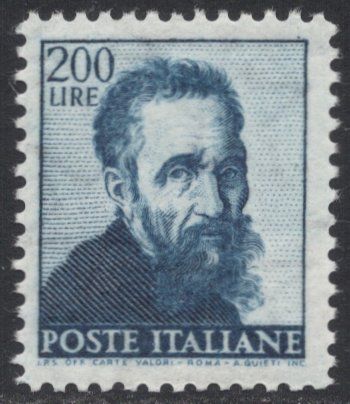Michelangelo, the Eternal Genius
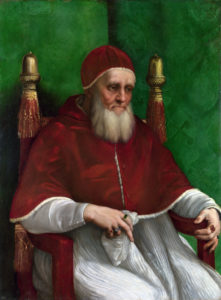
The relationship between Julius II and Michelangelo has been dramatized as a nasty battle of wills between two egocentric men. In actuality, Michelangelo’s issue with the Pope stemmed from the reality that Julius’ main focus was to expand the territory of the Papal States and the ensuing warfare that would be required. Michelangelo’s artistic projects would always be secondary to this fundamental.
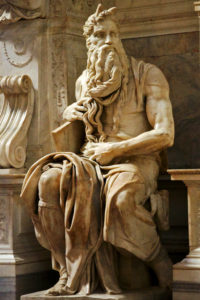
As soon as the Last Judgment was completed the Della Rovere clan began agitating for a completion of Julius II’s tomb. Luckily, Pope Paul wished to have Michelangelo focus on his own pet projects, namely a Vatican chapel dedicated in his honor. The pontiff helped negotiate a new agreement that limited Julius’ tomb to three main sculptures, including the Moses.
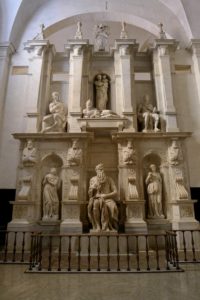
This was accepted and the more modest tomb was brought to a anti-climatic conclusion in 1545, with the completion of two statues, Leah and Rachel, placed to the left and right of Moses in a two story facade installed in the Church of San Pietro in Vincoli, the parish of Julius II. Although it has been described as the most impressive burial vault in Rome, Michelangelo summed up his perspective with one sentence “I lost the whole of my youth, chained to this tomb.”

With the ascendance of Giovanni as Leo X, Michelangelo’s brother Buonarotto achieved a prominent position within the Florentine government. Members of the Medici clan clamored for Michelangelo to return to his hometown and begin work on the unfinished facade of their parish church. A commission was formally offered, enormous amounts of marble were selected and ordered and a wooden model of the new facade was constructed. Just as work was to begin, Lorenzo de Medici, grandson of Il Magnifico and the most enthusiastic supporter of the project, died suddenly. Pope Leo X took another look at the probable expenses and cancelled the project, suggesting that a modest tomb be substituted. The tomb would evolve into the Medici Chapels, burial place of four members of the ruling family, including Lorenzo, Il Magnifico. Michelangelo would have to settle on spending the next two years on this project, also sweating out the death of Leo X and a new pope, Adrian VI, a reformer who bandied about the idea of destroying the Sistine chapel murals.
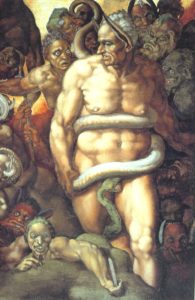
When Michelangelo refused new commissions from the Pope claiming his contract with Julius heirs’ forbade it until the troublesome tomb was complete, Paul III interceded and helped renegotiate the agreement. This allowed Michelangelo to work on another project, a fresco on the altar wall of the Sistine Chapel. Conceptually discussed with Clement VII as a depiction of the Resurrection, Michelangelo reconsidered and focused his creation on the the Last Judgment. Twenty-five years after finishing his previous work on the chapel, Michelangelo presented a different kind of painting. This work contained a wide range of emotion, depictions ranging from the sublime to the grotesque, and a focus on nudity that accentuated sensuality. This groundbreaking depiction of such a religious theme was controversial and at least one church official, Biagio da Cesena commented, “it was mostly disgraceful that in so sacred a place there should have depicted all of those nude figures, exposing themselves so shamefully.” He added that the work was more appropriate for a public bath or a tavern. Da Cesena’s reward for his art criticism was his depiction in the lower right corner of the painting, as Minos, judge of the underworld. To underline his contempt, Michelangelo added donkey ears, and a serpent biting Minos’ testicles.
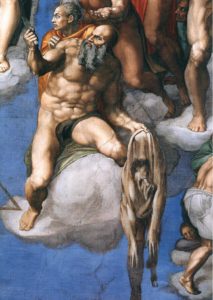
Michelangelo himself was not above ridicule in this depiction of symbolic judgment. In a central part of the fresco, St. Bartholomew is depicted holding a knife and the skin that represents his death by being skinned alive. This layer of skin has retained a human form and the head adorning this mass is clearly the tortured, gnarled face of Michelangelo. It would not be until the 1920’s that this detail was noticed.
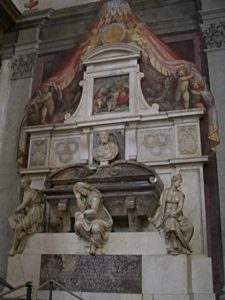
Leonardo knew that the current Pope Pius IV would insist that Michelangelo be enshrined at the finished St. Peter’s Basilica and he was determined to return him to Florence, which was his uncle’s wish. Leonardo hired a cart to surreptitiously and unceremoniously transport the wrapped body back to Tuscany, a trip that took eleven days. Michelangelo was interred with great fanfare in the Basilica of Santa Croce, in Florence, in an elaborate vault sponsored by both Cosimo de Medici and Giorgio Vasari.
Podcast: Play in new window | Download
Subscribe: RSS

